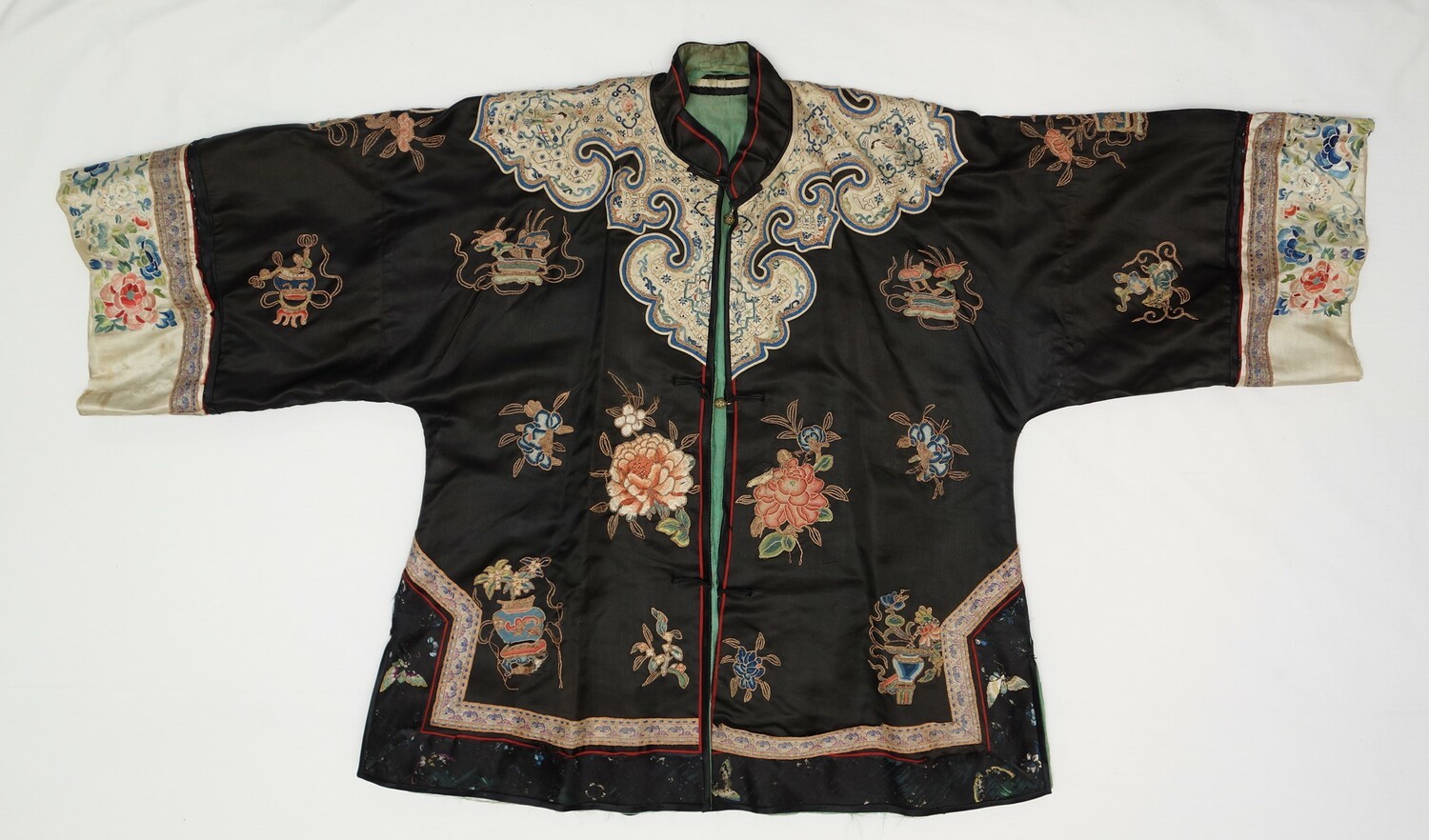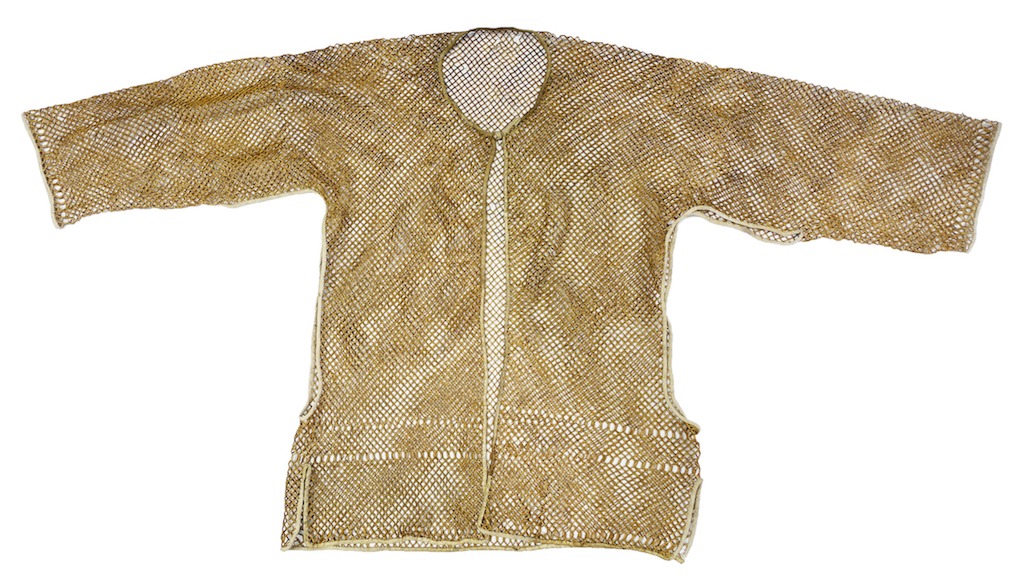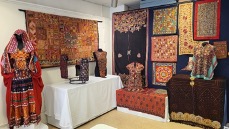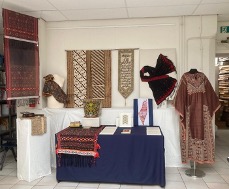Two exhibitions were held in the TRC Gallery in 2024. The first was about Chinese dress in the late 19th and early 20th centuries, while the second was about Shisha work (mirror embroidery) from Western India and beyond. A third exhibition, set up in the context of a special TRC project, 'Engaging textile heritage communities through citizen culture', was on show in the workroom at the TRC.
*****
Dragon robes, butterfly pins and lotus shoes: Clothing in Imperial Qing China
What did Chinese emperors, empresses and their court wear at the turn of the 20th century, and what did other people wear at that time? The TRC opened an exhibition on this theme and on display were a series of garments and accessories that were worn during the last imperial dynasty of China, namely the Qing dynasty (1644–1911).

The exhibition was opened on Thursday, 28 March, by Prof. Annetje Ottow, President of the Executive Board of Leiden University, Her family contributed to the exhibition (and the TRC Collection) by the donation of Chinese-style garments worn by relatives in the former Dutch East Indies in the early 20th century (see a TRC blog).
Thanks also to a donation by Quirina Vreeburg, the TRC was able to showcase a beautiful array of embroidered and woven dragon robes, decorated mandarin officials’ gowns, intricate women’s hair and body jewellery, embroidered shoes, Chinese-Indonesian garments, and so on.
The material, shapes, style and patterns of clothing in Qing China expressed a strictly regulated language. Clothing was regarded as a reflection of ethnic, social and political identity.
From mythical creatures embroidered on silk gowns, butterflies made from kingfisher feathers and mounted on silver hairpins, to simple netted bamboo undercoats (TRC 2023.2071), lotus shoes and 'boat' platform shoes: Every part of an outfit said something about the wearer, his position and identity.

The exhibition, curated by Augusta de Gunzbourg of the TRC, gives an overview of many elements of clothing worn at the dynastic court (from head to toe, literally) and by other people, but also gives a wider context to these garments.
Furthermore, the garments in this exhibition were worn during a moment of cultural and political transition in Chinese history, as the last ruling dynasty in China gave way to the 'modern' Chinese Republic.

The exhibition also highlighted Chinese clothing worn at that tumultuous time outside of China, as for instance in Indonesia, where political developments were very different from those in mainland China.
*****
Shisha embroidery from India and beyond
Inspired by a TRC masterclass held in early 2024, which included a demonstration of different techniques of applying small glass mirrors to a cloth ground, the TRC organised an exhibition about shisha work that was on view from September 2024 to January 2025.
 Exhibition at the TRC of 'traditional' Indian shisha embroidery. Photograph by Augusta de Gunzbourg.
Exhibition at the TRC of 'traditional' Indian shisha embroidery. Photograph by Augusta de Gunzbourg.
The exhibition featured over sixty examples of garments, panels and other objects with shisha work, including garments, complete outfits, panels, etc., all decorated with mirrors and embroidery. These included Banjara and Kutch items, as well as other examples from western India, notably Gujarat and Rajasthan, and beyond in Pakistan and Afghanistan.
Shisha work is a type of applied decorative needlework that is characterised by small pieces of reflective material that are sewn onto a cloth ground material. This technique is also known as mirror embroidery. It is popular in many parts of Asia. The term derives from (Persian) shisheh for 'glass'. In parts of India this type of work is also known as Abhala Bharat (Hindi).

It is believed that shisha embroidery originated in India in the seventeenth century, although it may well be older. The earliest extant examples of shisha embroidery used mica to create the shiny effect. Later the mica was replaced with tin or silver, and thin coins. Even beetle wings were sometimes used (see also TRC Needles: beetlewing embroidery). These were then replaced by glass in the early twentieth century. The glass was blown into large, thin bubbles and broken into small, round pieces – hence the earlier examples have a slight convex curve.
At first the making of mirrors for shisha embroidery was regarded as women’s work, but by the latter half of the twentieth century most of the glass was mass-produced with machine-cut glass with a silvered backing. By the end of the twentieth century shiny, plastic discs had more or less replaced the use of glass.
Shisha work is widely used on clothing (such as dresses and caps), as well as for wall and door hangings, covers and so forth. By the late nineteenth century shisha work of various types and styles was being produced in Afghanistan, China, Indonesia, India, Iran, as well as what was to become Pakistan.
Because the mica and mirror glass pieces have no holes that can be used to fasten the circles down to the ground material, a system of criss-cross threads is used. Sometimes a round, tin frame is placed over the glass and then the frame is sewn down onto the ground material. By the end of the twentieth century, small plastic frames were becoming more and more common as a method of holding down the mirror glass or plastic discs.
*****
TRC mini exhibition: 'Verbinding' (Connection)
by Maria Linkogle
The final activity for the Fonds voor Cultuurparticipatie project: 'Engaging textile heritage communities through citizen culture', was kicked off by the opening of this mini-exhibition with the title 'Verbinding' (Connection), on Tuesday, 1 October 2024. This comes after 18 months of participatory activities with diaspora community members, at the TRC Leiden.
 Mini TRC exhibition: VerbindingIn April 2023, we started inviting members of various diaspora communities belonging to cultural organisations and community centres primarily in Leiden, but also from Amsterdam and Capelle a/d IJssel.
Mini TRC exhibition: VerbindingIn April 2023, we started inviting members of various diaspora communities belonging to cultural organisations and community centres primarily in Leiden, but also from Amsterdam and Capelle a/d IJssel.
For this last activity, multi-media artist Ramia Suleiman joined the project team to help with developing the theme and concept of the mini-exhibition, and outreach for participants. This was more than a presentation of culture; it was a presentation of the participants' own emotional connection through textiles.
In Ghada Abhari and Herra Pahlasari we found a great team who were committed to work on every aspect of their exhibition. We had our first meeting with Ghada and Herra in July. They were asked to bring a textile object with which they had an emotional connection.
Ghada brought a wall hanging that belonged to her mother, which she brought back from Syria after her mother’s death. Herra brought her Ulos (piece of cloth used as a baby carrier), which was a gift she received from her mother-in-law when she had her first child.
We talked about the emotions that these items brought up. Feelings of being embraced by family was a strong emotion felt by both. We all agreed that this exhibition explores textile heritage and its role in our feeling of connection to where we come from in terms of geographical area and family. Textile material and immaterial heritage keep us connected to the places and the people we love and are reminders that they will always be with us. It was all about Verbinding.
 Guests at the opening of the TRC mini exhibition "Verbinding', 1 October 2024. Photograph by Maria Linkogle.
Guests at the opening of the TRC mini exhibition "Verbinding', 1 October 2024. Photograph by Maria Linkogle.
Throughout the whole process, we looked at items that belonged to Ghada and Herra, as well as items from the TRC and we came up with a collection of items that represented the feeling of connection to homeland and family. In the weeks before the exhibition, through a combination of in-person meetings and a continuous stream of messages in our app group, we nailed down the more practical matters. Most of the hands-on work of putting the exhibition display together happened on the Friday before the opening.
The evening was both joyous and emotional, from the opening speech to the talks by Herra and Ghada about what the process of setting up the exhibition was like for them. The discussions continued as we mingled around and enjoyed the delicious treats, especially the Indonesian snacks made by Herra. A special thank you to TRC volunteers who helped with the last minute preparations and during the exhibition.
See also:










